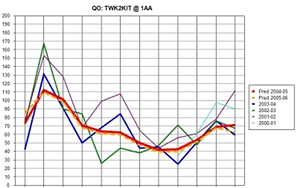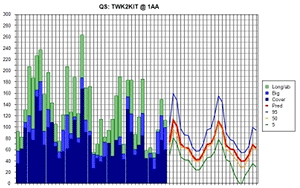How much effort is required to get the forecast right and how much is this worth?
Forecasting is not the only factor to fix
Forecast sales is not the only factor that must be adequately estimated. micq-if also considers factors such as:
Is it worth getting the forecasts all right. It depends. In the case of higher volume products with some history the effort is probably not that great and the value may be high, especially for a seasonal product. If seasonal products represent just 10% of your range they will often generate 20% of your revenue and maybe more of your inventory risk
For a lower turnover product, the forecast may be less important than properly understanding other aspects of retail demand … and for those products, other features of micq-if and their effective use will be more important in creating value. micq-if can provide you with a comprehensive and integrated set of capabilities. Importantly it is not a ‘one size fits all’ system. It will adapt to the product, forecast, supply and supply chain situation … and apply the appropriate tools to help you make better purchasing and inventory management decisions.

Forecasting is not necessarily that easy … but it can be made easier
There are many issues that conspire to make things tougher for supply planners. Sales didn’t advise that they won the BIG order until yesterday. And they want all the stock when? Well that is hard to manage, but maybe you could manage that better if you had the time.
micq-if can help you improve your forecasting capability by:
- applying a variety of methods (Box Jenkins, moving averages, exponential smoothing, regression, and some special techniques for seasonal products)
- selecting the best techniques for the different time periods and lead times
- detecting and analysing seasonality even when seasons start at different times from one year till the next, often because it rained earlier or later, or was unseasonably warm in one year
- optimising the orders that need to be included in the forecast based on customer lead times and order sizes, and considering the relative costs of stock transfers as opposed to carrying costs
- recognising where there are step changes in demand (it would have been nicer if sales told you about the loss of those customers earlier though)
- highlighting via a simple review score and colour coded warning system to help you focus on where perhaps the system might have struggled to come up with a ‘right enough’ answer. This can be presented when you are reviewing the forecasts that are potentially relevant to imminently important purchase order recommendations, or else highlighted when the purchase order recommendations are placed in front of you – sort of “I think that this recommendation is right but you might just want to check the forecast.”
- linking your forecasts to external data to help improve forecasting quality, and
- helping you manage manual overrides and mark abnormal orders and record reasons where necessary
So the effort need not be that great, once you set up the system and ensure the staff are equipped to take most advantage from what the system can deliver.
